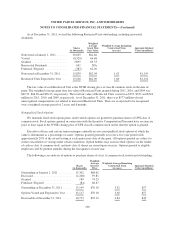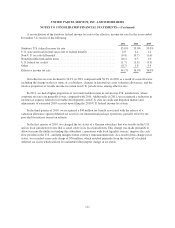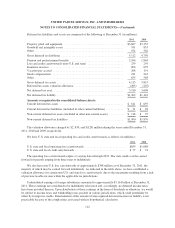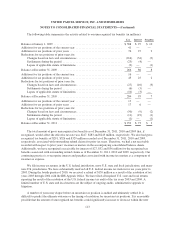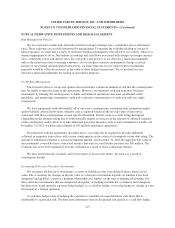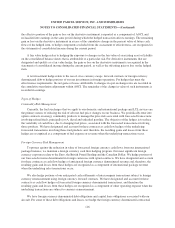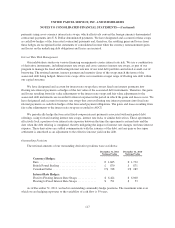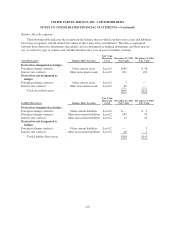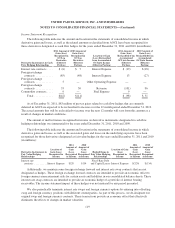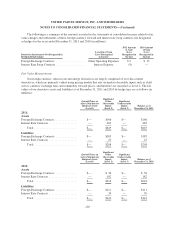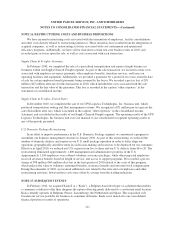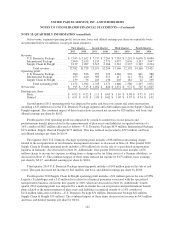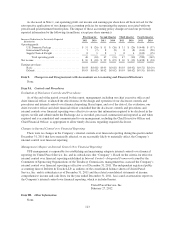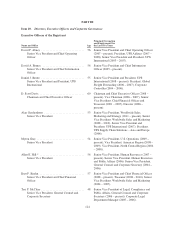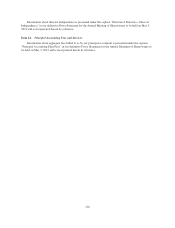UPS 2011 Annual Report Download - page 128
Download and view the complete annual report
Please find page 128 of the 2011 UPS annual report below. You can navigate through the pages in the report by either clicking on the pages listed below, or by using the keyword search tool below to find specific information within the annual report.UNITED PARCEL SERVICE, INC. AND SUBSIDIARIES
NOTES TO CONSOLIDATED FINANCIAL STATEMENTS—(Continued)
the effective portion of the gain or loss on the derivative instrument is reported as a component of AOCI, and
reclassified into earnings in the same period during which the hedged transaction affects earnings. The remaining
gain or loss on the derivative instrument in excess of the cumulative change in the present value of future cash
flows of the hedged item, or hedge components excluded from the assessment of effectiveness, are recognized in
the statements of consolidated income during the current period.
A fair value hedge refers to hedging the exposure to changes in the fair value of an existing asset or liability
on the consolidated balance sheets that is attributable to a particular risk. For derivative instruments that are
designated and qualify as a fair value hedge, the gain or loss on the derivative instrument is recognized in the
statements of consolidated income during the current period, as well as the offsetting gain or loss on the hedged
item.
A net investment hedge refers to the use of cross currency swaps, forward contracts or foreign currency
denominated debt to hedge portions of our net investments in foreign operations. For hedges that meet the
effectiveness requirements, the net gains or losses attributable to changes in spot exchange rates are recorded in
the cumulative translation adjustment within AOCI. The remainder of the change in value of such instruments is
recorded in earnings.
Types of Hedges
Commodity Risk Management
Currently, the fuel surcharges that we apply to our domestic and international package and LTL services are
the primary means of reducing the risk of adverse fuel price changes on our business. We periodically enter into
option contracts on energy commodity products to manage the price risk associated with forecasted transactions
involving refined fuels, principally jet-A, diesel and unleaded gasoline. The objective of the hedges is to reduce
the variability of cash flows, due to changing fuel prices, associated with the forecasted transactions involving
those products. We have designated and account for these contracts as cash flow hedges of the underlying
forecasted transactions involving these fuel products and, therefore, the resulting gains and losses from these
hedges are recognized as a component of fuel expense or revenue when the underlying transactions occur.
Foreign Currency Risk Management
To protect against the reduction in value of forecasted foreign currency cash flows from our international
package business, we maintain a foreign currency cash flow hedging program. Our most significant foreign
currency exposures relate to the Euro, the British Pound Sterling and the Canadian Dollar. We hedge portions of
our forecasted revenue denominated in foreign currencies with option contracts. We have designated and account
for these contracts as cash flow hedges of anticipated foreign currency denominated revenue and, therefore, the
resulting gains and losses from these hedges are recognized as a component of international package revenue
when the underlying sales transactions occur.
We also hedge portions of our anticipated cash settlements of intercompany transactions subject to foreign
currency remeasurement using foreign currency forward contracts. We have designated and account for these
contracts as cash flow hedges of forecasted foreign currency denominated transactions, and therefore the
resulting gains and losses from these hedges are recognized as a component of other operating expense when the
underlying transactions are subject to currency remeasurement.
We have foreign currency denominated debt obligations and capital lease obligations associated with our
aircraft. For some of these debt obligations and leases, we hedge the foreign currency denominated contractual
116


